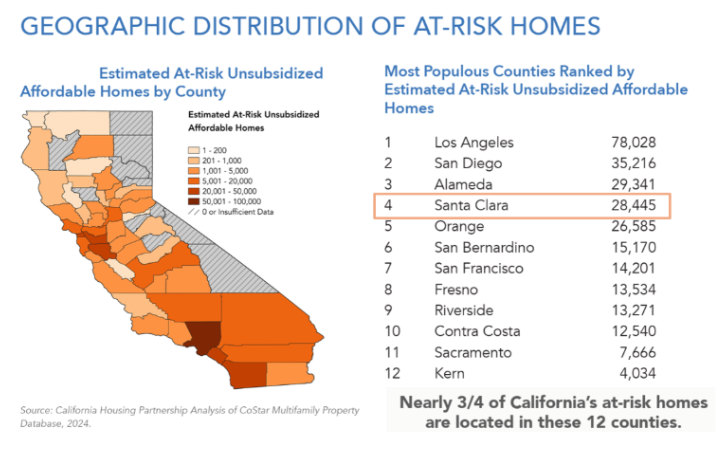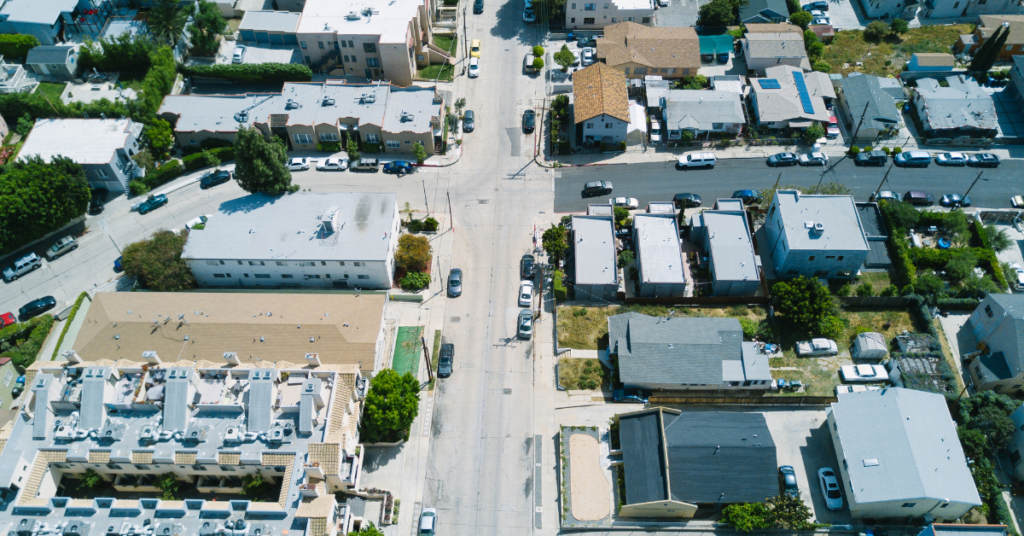Preservation — one of the “3 Ps” in the production, preservation, protection approach — is becoming increasingly urgent in Santa Clara County, where over 28,000 unsubsidized affordable homes are at risk of losing affordability, including more than 7,300 facing very high risk in the immediate term. Cities are starting to act through Housing Element programs, from Mountain View’s proposed $20M acquisition fund to San José’s Measure E–funded preservation of the Virginia Avenue Apartments — protecting 18 low-income households and advancing community ownership. Read the full article to learn how preservation efforts are moving forward and why expanding this work is critical to housing stability across the county.

Preservation programs are a critical part of local Housing Elements, working alongside production and tenant protection measures to prevent displacement, maintain affordability, and keep communities stable. They are also directly tied to California’s Affirmatively Furthering Fair Housing (AFFH) mandate under the state law AB 686, which requires jurisdictions to take meaningful actions to combat segregation and expand access to opportunity.
In April 2025, California Housing Partnership reported that Santa Clara County has 102,136 unsubsidized affordable rental homes, but over 28,000 are at risk of losing affordability — including 7,318 units at very high risk in the immediate term, and another 27% projected to be at risk within five years. Without intervention, these naturally occurring affordable homes could be lost to speculative acquisition and rent increases, accelerating displacement and reducing housing options for low-income households in our communities.
Progress on Preservation Programs in the 6th Cycle Housing Elements
Some Santa Clara County cities have integrated preservation into their 6th Cycle Housing Elements, though approaches and progress vary.
Mountain View: Acquisition Fund and Community Ownership Plan
Mountain View is advancing one of the region’s most significant local preservation efforts. In 2024, the City committed $4 million in housing funds toward a proposed $20 million acquisition/preservation fund for Community Stabilization and Fair Rent Act (CSFRA) units, contingent on securing $16 million from external partners. The City also launched development of a Community Ownership Action Plan to evaluate innovative models like community land trusts and cooperative housing.
Mountain View has tied preservation to its funding priorities — directing NOFA resources toward development and preservation with family-sized units, supportive housing, and accessibility upgrades. These efforts aim to produce at least 200 supportive housing units and increase the availability of larger affordable units for households otherwise excluded from the market.
San José: Preservation NOFA and the Virginia Avenue Apartments
In 2024, San José staff drafted a New Construction and Preservation Request for Proposals (RFP) for release in early 2025. This RFP will integrate the City’s Affordable Housing Siting Policy — prioritizing preservation and new construction in higher-resource neighborhoods — and include a points structure to incentivize projects that serve special needs populations.
A major early outcome tied to the City’s preservation strategy was the South Bay Community Land Trust’s (SBCLT) acquisition of the Virginia Avenue Apartments in early 2025 — the first time San José has used Measure E funds for affordable housing preservation. The San José City Council allocated $5 million from Measure E to support the acquisition and rehabilitation of this 18-unit apartment building, where nearly 89% of residents earn 40% or less of the area median income.
The acquisition, also funded by $4.5 million from BAHFA’s Regional Early Action Planning program, ensures long-term affordability through a 55-year deed restriction. SBCLT has committed to capping rents at 30% of income for severely rent-burdened households, freezing rents for one year, and undertaking immediate rehabilitation — backed by the $5 million City grant and $1.5 million from Destination: Home and other philanthropic partners.
This preservation of affordable units for working families reflects San José’s broader anti-displacement strategy, which has been informed by years of policy discussions and community mobilization around how to protect tenants and encourage community ownership models. It also demonstrates how targeted local funding can protect at-risk, unsubsidized affordable housing — a vital intervention in a county where thousands of similar homes are facing imminent risk.
Santa Clara: Voucher Advocacy Tied to Preservation
Santa Clara’s Action 14 links preservation to housing stability for vulnerable groups. In 2024, the City worked with a developer and the County to secure Veterans Affairs Supportive Housing (VASH) vouchers for elderly veterans as part of the Belovida Senior Apartments preservation effort. While no progress was reported on broader voucher outreach in 2024, this example shows how pairing vouchers with preservation projects can protect long-term residents from displacement. Additionally, cities must pivot to fill the gap emerging from potential federal government cuts to voucher programs.
Sunnyvale: Accessibility and Code Updates as Preservation Tools
Sunnyvale’s Program H31 focuses on removing barriers for residents with disabilities through reasonable accommodation regulations and ongoing accessibility code updates. While framed as a fair housing measure, this work also functions as preservation — ensuring that existing housing remains usable and safe for residents with mobility or accessibility needs. Implementation is scheduled to advance in 2025.
Trends and Challenges
What’s working:
- Cities like Mountain View are creating dedicated acquisition funds and linking them to Housing Element goals.
- San José’s Measure E-funded acquisition of the Virginia Avenue Apartments shows how targeted investment can preserve housing for extremely low-income residents while advancing community ownership.
- Some jurisdictions are embedding preservation into broader anti-displacement and equity strategies, tying it to community engagement, larger-unit production, and accessibility upgrades.
What’s missing:
- Many programs remain underfunded or contingent on outside funding.
- Reporting can be vague, especially for programs that combine multiple actions under one program header.
- Few cities track who benefits from preservation investments or whether projects are located in areas at the highest risk of displacement, despite data showing that over 28,000 unsubsidized affordable homes in Santa Clara County are currently at risk.
Opportunities for Stronger Preservation
To strengthen preservation locally, cities can:
- Establish flexible local funds to act quickly on acquisition opportunities.
- Prioritize anti-displacement outcomes so preserved homes serve current residents.
- Partner with nonprofits and community-based developers/stewards for long-term affordability.
- Use county-level data to target the most at-risk properties.
For more strategies — including innovative models from San Francisco, Los Angeles, and Long Beach — see our previous article: Preserving Affordable Housing: Local Strategies to Prevent Displacement and Foster Stability.
Preservation is more than just maintaining buildings — it’s about safeguarding communities, cultural networks, and opportunities for long-term stability. The Virginia Avenue Apartments acquisition is a prime example of how cities can combine local funding, community partnerships, and innovative community ownership models to prevent displacement and ensure long-term affordability. With more than a quarter of Santa Clara County’s unsubsidized affordable housing stock at risk, the need for proactive preservation has never been more urgent.
